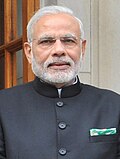Top Qs
Timeline
Chat
Perspective
Government of Gujarat
Indian State Government From Wikipedia, the free encyclopedia
Remove ads
The Government of Gujarat, also known as Gujarat Government, is the supreme governing authority of the Indian state of Gujarat and its 33 districts. It consists of an executive of the legislators appointed by the Governor of Gujarat, a judiciary and of a publicly elected legislative body.
Remove ads
Like other states in India, the head of state of Gujarat is the Governor, appointed by the President of India on the advice of the Central (Union) government. The governor's role is largely ceremonial, but the governor considers the legislative composition and appoints the Chief Minister, who is the main head of government, as chair of the Council of Ministers of Gujarat and is vested, in some instances alone but as to most executive powers by Council consensus with virtually all of the executive powers.
Gandhinagar, the capital of Gujarat, houses the relevant Vidhan Sabha (also known as the Gujarat Legislative Assembly) and the secretariat. The Gujarat High Court in Ahmedabad, has jurisdiction over the state as to state laws.[1]
The present legislative assembly is unicameral, consisting of 182 Members of the Legislative Assembly (M.L.As). Its term is 5 years, unless sooner dissolved.[2][3]
Remove ads
Legislature
The Gujarat Legislative Assembly or Gujarat Vidhan Sabha is the unicameral legislature of the Indian state of Gujarat, in the state capital Gandhinagar. Presently, 182 members of the Legislative Assembly are directly elected from single-member constituencies (seats). It has a term of 5 years unless it is dissolved sooner. 13 constituencies are reserved for scheduled castes and 27 constituencies for scheduled tribes. From its majority party group or by way of a grand coalition cabinet of its prominent members, the state's Executive namely the Government of Gujarat is formed.
Since 1995, the Gujarat Legislative Assembly has been controlled by the Bharatiya Janata Party with an absolute majority in the House.Remove ads
Administration and Local governments
Local governments function at the basic level. It is the third level of government apart from union and state governments. It consists of panchayats in rural areas and municipalities in urban areas. They are elected directly or indirectly by the people. "Structurally Gujarat is divided into districts (Zila), Prant (subdivisions), Taluka (blocks) & villages. The state is divided into 33 districts, 122 prants, 248 talukas.[4] There are 08 municipal corporations, 156 municipalities and 14,273 Panchayats, for administrative purposes.'
| India | |||||||||||||||||||||||||||||||||||
| Gujarat | |||||||||||||||||||||||||||||||||||
| Districts | |||||||||||||||||||||||||||||||||||
| Prant (Subdivisions) | Municipal Corporations (Mahanagar Palika) | Municipalities (Nagar Palika) | Town Council (Nagar Panchayat) | ||||||||||||||||||||||||||||||||
| Taluka (Block/Tehsil) | Wards | ||||||||||||||||||||||||||||||||||
Remove ads
Institutes
- Institute of Infrastructure Technology Research and Management, Ahmedabad is an autonomous university established by Government of Gujarat.
State Public Sector Undertakings
For an exhaustive list, see List of agencies of the government of Gujarat.
Executive
Cabinet Minister
Minister of State (Independent Charges)
Minister of State
- Sources
- [5]
Remove ads
Prime ministers of Kathiawar/Saurashtra (1948-50)
Chief ministers of Saurashtra (1950-56)
Chief ministers of Gujarat
Summarize
Perspective
Remove ads
See also
Notes
- President's rule may be imposed when the "government in a state is not able to function as per the Constitution", which often happens because no party or coalition has a majority in the assembly. When President's rule is in force in a state, its council of ministers stands dissolved. The office of chief minister thus lies vacant, and the administration is taken over by the governor, who functions on behalf of the central government. At times, the legislative assembly also stands dissolved.[6]
Remove ads
References
External links
Wikiwand - on
Seamless Wikipedia browsing. On steroids.
Remove ads












